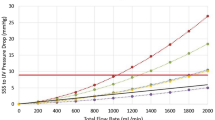Abstract
Twenty-one dogs were rendered hydrocephalic by the intracisternal injection of kaolin. After various intervals between 1 and 44 days the animals were anesthetized for the measurement of arterial (lingual), ventricular, and sagittal sinus pressures. Following the recordings the animals were sacrificed by formalin infusion, the brains sectioned serially, and ventricular size measured. In general, the longer the period of incubation the larger the ventricles. There was no correlation between the degree of hydrocephalus and mean or pulsatile ventricular pressure. All animals with a pressure of less than 9 torr demonstrated non-linear transmission of the arterial wave into the CSF (which is the same as the pulse in the venous bed). All animals with a pressure greater than 12 torr had linear transmission of the wave. These findings in the hydrocephalic animals are the same as those found in non-hydrocephalic animals with similar pressures. It is concluded that the CSF pulse wave seen in hydrocephalic dogs is a result of how the cerebrovascular bed processes the cardiac pulse wave and is independent of the hydrocephalic process. There is no evidence that the pulse wave produces hydrocephalus.
Similar content being viewed by others
References
Becker DP, Wilson JA, Watson GW (1972) The spinal cord central canal: response to experimental hydrocephalus and canal occlusion. J Neurosurg 36:416–424
Bering EA Jr (1955) Choroid plexus and arterial pulsation of cerebrospinal fluid. Arch Neurol Psychiatry 73:165–172
Bering EA Jr (1962) Circulation of the cerebrospinal fluid. Demonstration of the choroid plexus as the generator of the force for flow of fluid and ventricular enlargement. J Neurosurg 19:405–413
Chopp M, Portnoy HD (1980) Systems analysis of intracranial pressure. Comparison with volume-pressure test and CSF-pulse amplitude analysis. J Neurosurg 53:516–527
Chopp M, Portnoy HD, Branch C (1983) Hydraulic model of the cerebrovascular bed: an aid to understanding the Volume-Pressure Test. Neurosurgery 13:5–11
Chopp M, Portnoy HD, Branch C (1983) Cerebrospinal fluid and cerebral venous pressures during intracranial hypertension. Systems analysis and hydraulic model. (Submitted for publication)
Dardenne GA, Dereymaker A, Lacheron JM (1969) Cerebrospinal fluid pressure and pulsatility. An experimental study of circulatory and respiratory influences in normal and hydrocephalic dogs. Eur Neurol 2:193–216
DuBoulay GH (1966) Pulsatile movements in the CSF pathways. Br J Radiol 39:255–262
Dunbar HS, Guthrie TC, Karpell B (1966) A study of the cerebrospinal fluid pulse wave. Arch Neurol 14:624–630
Eisenberg HM, McLennan JE, Welch K (1974) Ventricular perfusion in cats with kaolin-induced hydrocephalus. J Neurosurg 41:20–28
Hamer JE, Alberti E, Hoyer S, Widemann K (1977) Influence of systemic and cerebral vascular factors on the cerebrospinal fluid pulse waves. J Neurosurg 46:36–45
Hamit HF, Beall AC Jr, DeBakey ME (1965) Haemodynamic influences upon brain and cerebrospinal fluid pulsations and pressures. J Trauma 5:174–184
Kumar AJ, Hochwald GM, Kricheff I, Chase N (1976) Positive contrast ventriculography in cats with experimental obstructive hydrocephalus. Invest Radiol 11:605–611
Marmarou A, Shulman K, La Morgese J (1975) Compartmental analysis of compliance and outflow resistance of the cerebrospinal fluid system. J Neurosurg 43:523–534
Nakamura S, Camins MB, Hochwald GM (1983) Pressure-absorption responses to the infusion of fluid into the spinal cord central canal of kaolin-hydrocephalic cats. J Neurosurg 58:198–203
Pettorossi VE, DiRocco C, Mancinelli R, Caldarelli M, Velardi F (1978) Communicating hydrocephalus induced by mechanically increased amplitude of the intraventricular cerebrospinal fluid pulse pressure: rationale and method. Exp Neurol 59:30–39
Portnoy HD, Chopp M (1981) Cerebrospinal fluid pulse wave form analysis during hypercapnia and hypoxia. Neurosurgery 9:14–27
Portnoy HD, Chopp M, Branch C, Shannon MB (1982) Cerebrospinal fluid pulse waveform as an indicator of cerebral autoregulation. J Neurosurg 56:666–678
Portnoy HD, Chopp M, Branch C (1983) Hydraulic model of myogenic autoregulation and the cerebrovascular bed. Effects of altering systemic arterial pressure. Neurosurgery 13:482–498
Sklar FH, Diehl JT, Beyer CW, Clark WK (1980) Brain elasticity changes with ventriculomegaly. J Neurosurg 53:173–179
Torvik A, Murthy VS (1977) The spinal central canal in kaolin-induced hydrocephalus. J Neurosurg 47:397–402
Author information
Authors and Affiliations
Rights and permissions
About this article
Cite this article
Portnoy, H.D., Branch, C. & Chopp, M. The CSF pulse wave in hydrocephalus. Child's Nerv Syst 1, 248–254 (1985). https://doi.org/10.1007/BF00272020
Issue Date:
DOI: https://doi.org/10.1007/BF00272020




